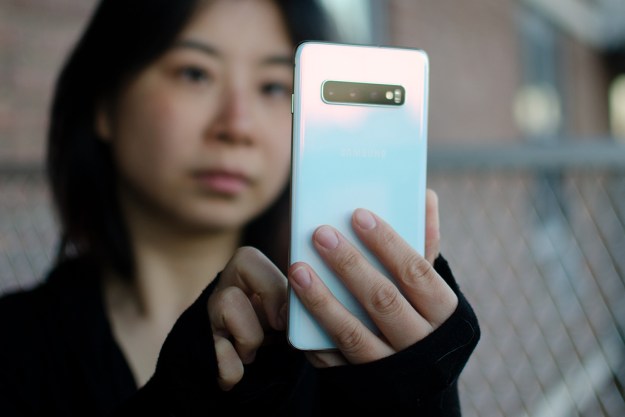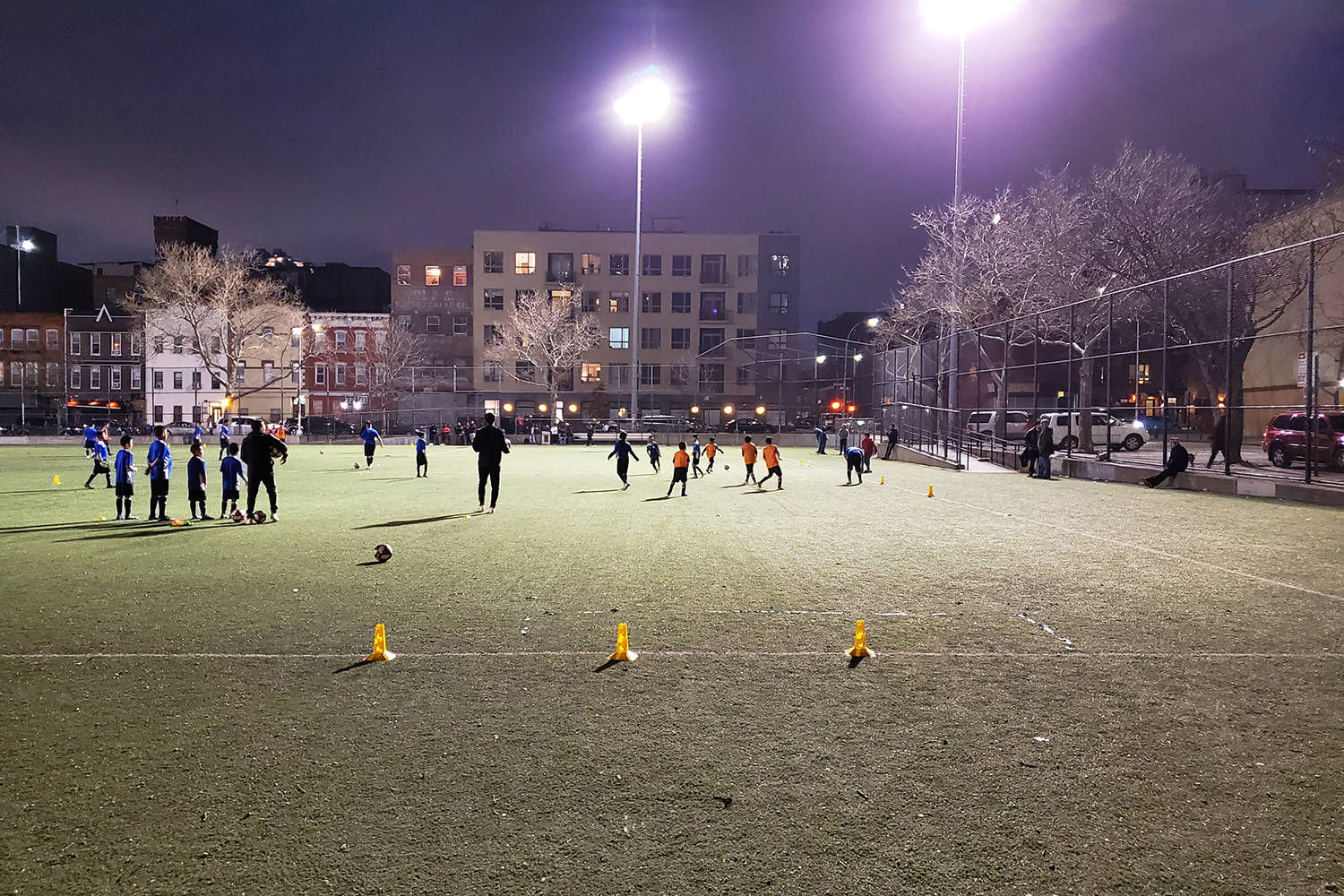
“Samsung’s Galaxy S10 is eclipsed by the S10 Plus, and the S10e offers better value, but it’s still a great phone.”
- Speedy performance
- Day-long battery life
- Versatile triple cameras
- Excellent HDR10+ screen
- Clean OneUI software
- Slim bezels mean accidentally interacting with the screen
- Too close in price to the better S10 Plus
- Expensive
Having reviewed the Samsung Galaxy S10 Plus, then the Galaxy S10e, and now the Galaxy S10, Samsung’s middle child in its new smartphone range doesn’t strike me as particularly notable. It has all the tenets of a good phone, yes, but it’s overshadowed by the S10 Plus (which has a few other advantages) and is just $100 more. The Galaxy S10e offers better value at $750.
The two reasons you’d want the S10 over the S10 Plus involve saving just a little bit of money, or the 6.1-inch screen size is just right for you. You’ll be getting many of the same, excellent features — from triple cameras on the rear to an almost true edge-to-edge screen experience. This is a phone that won’t disappoint.
Gorgeous display
The S10’s display is gorgeous. The edges around the 6.1-inch screen are tiny, offering a stunning bezel-less experience that makes watching movies and reading on the web a joy.

The bezels are razor-thin thanks to the new “hole-punch” Infinity-O display from Samsung, where a laser cuts out a small hole at the top right of the screen without damaging the pixels. This is what allows the camera to float on the display, like a hole punch in a piece of paper. I think it looks a lot better than the notch on phones like the iPhone XS, though a true full-screen experience would obviously be ideal (like on the Oppo Find X).
The status bar is now a little bigger thanks to the hole-punch camera, but most apps look good in portrait orientation, and I never found the floating camera to be distracting. It’s a bit of a different story when you swap to landscape orientation, as the screen looks a little funky. Third-party apps don’t wrap around the hole-punch camera, but use a black bar that ruins the symmetry of the bezels. You end up with a thicker bezel on the side with the selfie camera in games such as Alto’s Odyssey.
It’d be nice if full-screen apps adapted to make use of the screen space. YouTube, for example, lets you watch a full-screen video that goes edge-to-edge on the S10, which looks more immersive, but Netflix has yet to add support. That doesn’t work for all videos on YouTube though, as it depends on the aspect ratio the video was filmed in.

The screen technology is new on the S10; Samsung calls it a “Dynamic AMOLED” display. It’s the first screen to be HDR10+ certified. I can attest that the screen is crisp, especially when you set it to the Wide QHD+ (3,040 x 1,440) resolution (it’s on Full HD+ by default). The screen is bright and easy to read in direct sunlight — just look how it eclipses the Google Pixel 3 XL in the picture above.
The gorgeous screen is paired with great audio from the Dolby Atmos-supported stereo speakers. I’d have preferred to see two front-facing speakers like on the Pixel 3 or the Razer Phone 2, but the sound on the S10 is plenty loud. Oh, and whaddaya know — there’s a headphone jack too if you still want to plug in the old way.
It’s not all good news, though. The S10 does have the same shortcoming I experienced with the S10 Plus. It’s easy to activate the screen accidentally or tap on random letters on the virtual keyboard when it’s open, simply by holding the phone. The skimpy bezels made it possible for my palm to constantly touch the screen. However, the issue is less frequent compared to the 6.4-inch S10 Plus.
The 6.1-inch screen is not as unwieldy as the S10 Plus, but it’s not easy to hold with one hand, unlike the 5.8-inch Galaxy S10e. The difference in size may be apparent when you look at both phones, but it’s not as noticeable when they are in your hands, which is why it may make more sense to shell out an extra $100 for the S10 Plus for the extra screen real estate.
Clean design, in-display fingerprint sensor
I’m often ranting about how smartphones could use more color, which is why I love the varied color choices on phones like the iPhone XR. However, there’s an iridescent nature to the Prism White Galaxy S10 that’s admirable. You can also get the S10 in a Flamingo Pink, Prism Blue, and Prism Black. The latter two look good, but I’d be split between the white and the pink colors.
It helps that the rear design is simplified, letting the color to make a statement. All you’ll find is a horizontal camera module, like on the Galaxy Note 9, as well as the Samsung logo. I love how the module is blacked out, which adds to the minimal look.

The aluminum frame isn’t completely rounded, and there’s a flat enough edge to offer a strong grip when holding the phone — important as both the front and back are glass (Gorilla Glass 6 on the front, Gorilla Glass 5 on the back). You should get a case to protect the phone from scratches and drops. Speaking of the metal used in the body of the phone — it’d have been nice to see stainless steel here like Apple used on the iPhone XS and XS Max, which is more scratch resistant and tougher than aluminum.
There’s an iridescent nature to the Prism White Galaxy S10 that has me admiring it.
You may have noticed something’s missing. Yep, there’s no fingerprint sensor. On the Galaxy S10 and S10 Plus, Samsung has moved the sensor under the display on the front — it’s called an embedded ultrasonic fingerprint scanner; and it captures 3D contours of thumbs and fingerprints for more secure biometric authentication. In-display fingerprint sensors aren’t new — phones like the OnePlus 6T, the Nokia 9 PureView, and the Huawei Mate 20 Pro all have them, but they use different technology.
Samsung’s tech is ultrasonic, and in my experience, it’s the best in-display fingerprint scanner to date. There are machine-learning algorithms in place to prevent spoofing, and the fingerprint data never leaves the device. The sensor is certified by the FIDO Alliance (Fast Identity Online), so you can be sure it’s secure, and that also means it can be used to unlock sensitive apps — like the one for your bank — or to authenticate payments.

Like the fingerprint sensor on the back of phones, you do need to precisely place your thumb or finger on the right spot — at the bottom of the S10’s screen — to unlock the phone. It takes some getting used to. Is it as quick or accurate as traditional fingerprint scanners on the back of phones? No. But it’s not far off.
If you set up the face unlock option, it’s near impossible to use the fingerprint sensor because the phone unlocks so quickly. However, face unlock is not as secure — it can be triggered with just a picture of your face. You can turn off “faster recognition” for added security, but that’s still not guarantee. Apple’s Face ID is a better option.
In some situations, you can see the in-display fingerprint sensor on the screen when the phone is in direct sunlight. There’s a thread about this in a Samsung community forum, and a Samsung moderator said it’s “not a defect” and you should just “lower the brightness on the screen” to avoid seeing it.
Powerful specs, One UI software
The S10, like the rest of the 2019 Galaxy S10 range, is powered by Qualcomm’s Snapdragon 855 processor, which is the flagship chipset that powers most high-end Android phones this year. It’s paired with a whopping 8GB of RAM inside, along with 128GB of internal storage, though a MicroSD card slot is available in case you need to add more space.
There is a distinction between the Galaxy S10e, S10 and S10 Plus when it comes to performance. Only the S10 Plus has a special vapor chamber cooling system to prevent the phone from overheating in demanding apps. You should be able to play graphically-intensive games like Fortnite or PUBG: Mobile for longer on the S10 Plus.
I managed to play games like PUBG: Mobile, Alto’s Odyssey, and Breakneck without issue on the S10. It did get warm after 15 to 20 minutes of use, but I didn’t notice any changes in performance even after playing for 30 minutes.
Here are our benchmark results:
- AnTuTu 3DBench: 347,069
- Geekbench CPU: 3,426 single-core; 10,441 multi-core
- 3DMark Sling Shot Extreme: 4,504
The AnTuTu score is among the highest I’ve ever recorded on a smartphone (higher than the iPhone XS), only bested by the Xiaomi Mi 9 and the Galaxy S10e, both of which have the same Snapdragon 855 chip. The iPhone XS does beat out the S10 in Geekbench scores, though.
Paired with this strong performance is Samsung’s new One UI software theme, which is running the latest version of Android 9 Pie. I like the look of the revamped interface, and critical elements of the user interface are placed toward the bottom of the screen for easier access. I’m also a big fan of the darker themes that protect my eyes when using the phone at night.
There are small details that make the software shine in a way I’ve never seen before with a Samsung phone — like how a light circles the hole-punch camera when you swap to selfie mode or when the camera is trying to find your face to unlock the phone. The software is also deeply customizable – you can ditch the traditional Android navigation bar if you want. Short of the software on the Google Pixel 3 and the OnePlus 6T, One UI is one of my favorite interfaces on a phone right now.
Software updates may prove lacking, however. The unlocked version of the Galaxy S9 got Android 9 Pie six months after Google released it, which is disappointing. That kind of delay is non-existent on Pixel phones or iPhones, and I hope the S10 will get updated to Android Q at a faster pace this year.
The Galaxy S10e, S10, or S10 Plus can’t connect to 5G networks as they don’t have the required Qualcomm X50 modem inside (using the modem with the chip is an opt-in feature). Samsung has decided to make a special-edition Galaxy S10 5G instead, which will be able to connect to the next-generation mobile network, and it arrives sometime in the second quarter of the year. 5G service isn’t generally available yet, however, so it’s only a concern if you intend to hold on to the phone for years and need to future-proof.
Bixby
The Bixby button is still present on the S10, but it’s no longer an object of hatred. Why? Samsung pushed out an update that allows you to remap the Bixby button. To be fair, Bixby has performed well the times I have asked to set it reminders or asked it queries. But I have grown used to Google Assistant, which is also available on the phone, and often delivers better results.

Remapping Bixby is a bit limited. You can set the button to open another app, but a double press (or long press) will still open Bixby. Or you can set it to open an app with a double press, and a single press will open Bixby. There’s no way to completely disable Bixby Voice and there’s no native way to remap the button to open Google Assistant, but there’s a workaround if you’re willing to install a third-party app.
There is one new improvement to Bixby in the S10 — Bixby Routines — but I doubt Bixby’s “A.I.” has much to do with it. Routines works like IFTTT, where you can set up different profiles for your phone based on certain triggers. For example, I’ve set the phone to turn on sound when I arrive home, and to switch to mute when I arrive at work. It’s a powerful feature, and I like using it.
Triple cameras
You get the same rear camera experience between the Galaxy S10 and the S10 Plus. In years past, Samsung has always offered an extra camera on the Plus model — like on the Galaxy S9 Plus — offering a stronger reason to buy it over the smaller Galaxy S9. This year’s S10 Plus does have an extra camera, but it’s on the front, and it’s a depth-sensing camera (more on this below).
There are three cameras on the back of the S10 and S10 Plus: A standard 12-megapixel lens with a variable f/1.5 to f/2.4 aperture (which Samsung first debuted last year) is paired with a 12-megapixel telephoto lens with a f/2.4 aperture. These two lenses are the same ones you’ll find on last year’s S9 Plus. The new, third camera is a 16-megapixel ultra-wide-angle lens with a f/2.2 aperture.
Triple camera setups on smartphones aren’t new. The S10 is joining the ranks of phones like the Huawei Mate 20 Pro and the LG V40 ThinQ, which have similar setups. But one thing I’ve learned from testing phones with triple cameras is that they are far more versatile than single- or even dual-lens cameras. Want a close up? Use the telephoto lens for 2x optical zoom. Want to capture a group photo? Swap to the ultra wide-angle lens. Transitioning between these lenses feels fast and fluid — either tap on the respective lens icons in the camera app, or just pinch in or out on the viewfinder and the phone will automatically swap to the relevant lens.
- 1. Galaxy S10
- 2. Nokia 9
Daytime photos captured by the S10 can look stunning. The phone does a good job of keep photos well-exposed — you won’t often run into blown out or under-exposed areas, thanks to HDR. Detail is strong, and colors don’t look too oversaturated. I did notice that photos tend to lack contrast, so they can look a little washed out, and they often have a warmer tone.
The S10 can take solid photos in low-light environments as well, but details start to look fuzzy, and colors don’t look as accurate. There’s no proper night mode like on the Pixel 3 with Night Sight or the Mate 20 Pro with Night mode, which means it can’t offer stellar night photography. You’re best off using the standard lens in dark conditions, as the telephoto and wide-angle lenses deliver muddy images in these conditions.
There are so many moments when a wide-angle lens makes more sense, and I’ve had a ton of fun using it.
It’s not the best camera, but it’s still a fun, snappy camera to use, and the triple-lens setup adds tremendous value, particularly the wide-angle lens. The wide-angle lens makes sense, and I’ve had a ton of fun using it, even if it does have some distortion and doesn’t offer the strongest detail.
What’s new with the camera software? Samsung has expanded Scene Optimizer’s shooting modes to 30 (that’s 10 new scenes, including dog, cat, shoes, and baby). Scene Optimizer uses artificial intelligence to automatically detect scenes like sunsets or people and attempts to adjust your photo to what it thinks looks best. I left it on for most of our testing, and it does help images pop, but can lead to oversaturation at times.
My favorite feature is Shot Suggestions, which suggests straightening the camera if you’re tilting it, while also suggesting better compositions. All you need to do is point the camera at the recommended “Best Shot” and the phone will take the photo. It eliminates the need to tap the shutter button completely.
Samsung’s Portrait Mode is called Live Focus, which is where a blur effect is added behind a subject. Live Focus photos aren’t as good as what I’ve seen from the Google Pixel 3 or the Nokia 9 PureView — details aren’t as strong, especially in low light, and the blur effect can look messy. I do like the new Live Focus mode called Color Point, which keeps the subject in color while making everything else black and white. It may take a few tries before you get the perfect shot, but it’s a fun effect.
What’s more impressive is the camera’s 4K HDR video. It offers a cinematic look and it’s quite colorful. There’s also a “Super Steady” mode for when you want to capture stable video on the move. It’s all impressive, but there are limitations. You can’t shoot 4K HDR at 60 frames per second, for example, just at 30FPS. You can’t use Steady Shot if you’re shooting in HDR, the quality is restricted to 1,920 x 1,080, and it only works with the main lens. And you need to manually change these settings, which is annoying.
Where the S10 differs from the S10 Plus is the front camera setup, as the latter phone has two cameras, as opposed to the single one on the S10. It’s a 10-megapixel lens with f/1.9 aperture, which can now capture 4K UHD video. Selfies look good, though detail doesn’t shine through like it does on the Pixel 3.
The S10 Plus’ additional 8-megapixel lens with a f/2.2 aperture does help it take stronger Live Focus selfies over the S10, as the extra lens is there to capture better depth data. Just look at the comparison below, and it’s easy to see which photo is better. The S10 Plus photo is more colorful, too.
- 1. S10
- 2. S10 Plus
Samsung’s AR Emoji animations look less janky on the S10 Plus, though they’re not as good as Apple’s Memoji. Also, Samsung’s AR Emoji always get my skin color wrong.
Day-long battery
The Galaxy S10, much like the Galaxy S10 Plus, will get you through a solid day of use. I frequently arrived home with under 40 percent left, around 6 p.m. Plan on spending the night out? The phone still managed to last, only hitting around 15 percent close to 11:30 p.m.
In our 10-hour video battery test, the S10 lasted for 10 hours and 50 minutes, a strong effort and one of our best scores. It’s beat by the Galaxy S10 Plus, which lasted 12 hours and 40 minutes. If you prize battery life, the S10 Plus may be the better choice, but you won’t be disappointed with the S10.
The S10 has a feature called Wireless PowerShare, which lets you recharge any Qi-enabled products by placing it on the back of the phone, effectively turning it into a wireless charging pad. That means you can recharge a friend’s iPhone XS, for example, if they’re low on juice. I juiced up Samsung’s Galaxy Watch Active from 25 to 33 percent in 10 minutes, and the phone lost around 5 percent.
Though it lasts a long time, the S10 still uses Qualcomm’s aging Quick Charge 2.0 fast charging technology. Many phones have moved on to Quick Charge 3 or 4, which charge much more quickly.
Price, availability, and warranty information
The Samsung Galaxy S10 costs $900, and is available for purchase now from all major retailers and carriers globally. Check out our guide to purchasing the new S10 range for more details.
Samsung offers a standard one-year warranty that protects the phone from manufacturer defects.
Our Take
The Galaxy S10 is the middle child between the S10e and the S10 Plus, and there are few reasons to buy it over the others. It’s an extremely capable phone that hits all the right marks, but it may be worth spending the extra $100 for the S10 Plus.
Is there a better alternative?
The S10 Plus is worth the extra cash. Its upgrades do make it a better phone — namely the better battery life and better selfies.
If software updates are important, then I recommend buying the Google Pixel 3 or 3 XL. They have the best cameras on a phone, great screens, and excellent software interfaces, though battery life suffers. And if iOS is an alternative you’re considering, then buy the iPhone XS. Check out our best smartphones guide for more options.
How long will it last?
The Galaxy S10 should last you three to four years, if not more. It’s built well, though the glass will be prone to cracks if you don’t protect it. An aging battery will likely be the first sign you need to upgrade.
Samsung’s slow to roll out Android updates, but the S10 should get software updates for two years at the least.
Should you buy it?
Yes, though upgrading to the S10 Plus is worthwhile. The Galaxy S10 is the awkward middle child in Samsung’s line-up, but it’s still an excellent phone, and you’ll be satisfied with your purchase.
Editors' Recommendations
- The Galaxy Z Fold 6 and Flip 6 release date just leaked
- Best Samsung Galaxy S22 deals: Save big on unlocked models
- Samsung just launched a $400 phone in the U.S., and it looks great
- Best Samsung Galaxy Z Flip 5 deals: Get the foldable for free
- Best phone deals: Save on the iPhone, Galaxy Z Fold 5, and more





















